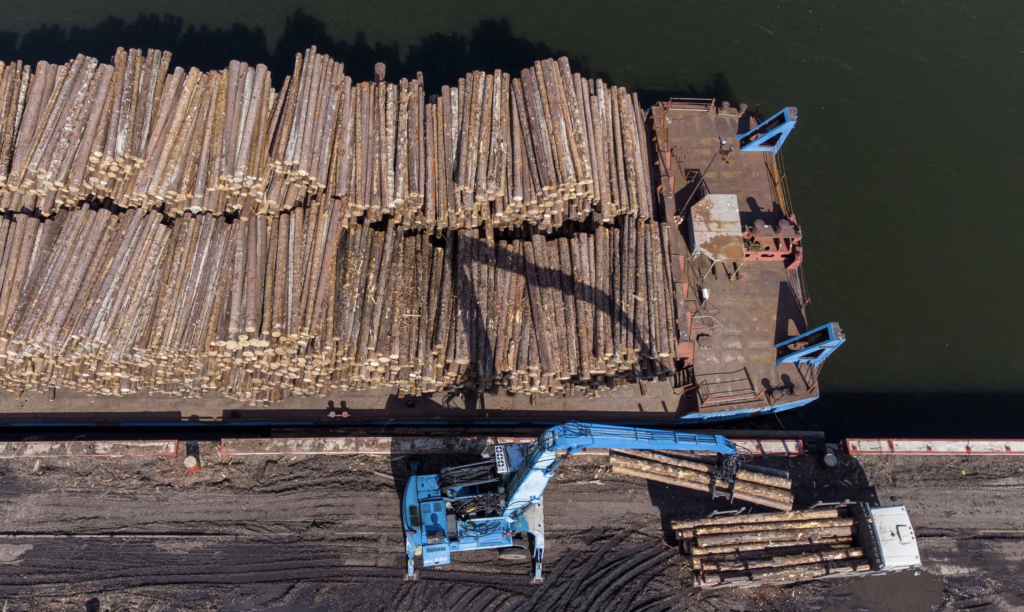Wood products sold in the UK has that nearly half of the samples labeled as sustainably sourced from countries like Ukraine, Poland, Estonia, and Latvia do not originate from those countries. Instead, the chemical composition of the wood suggests that much of it may have come from Russia or Belarus, despite sanctions that ban imports from both nations.

Investigation Team
A Crack in the Chain of Trust
Despite sweeping international sanctions and rigorous certification schemes, new forensic research has uncovered a troubling loophole in the UK’s timber supply chain. Birch wood products—widely used in furniture, interiors, and musical instruments—claimed to be from Eastern European countries like Ukraine, Poland, and Latvia are, in many cases, likely smuggled in from Russia and Belarus, countries currently under strict trade sanctions.
A groundbreaking study by World Forest ID, a research consortium involving Kew Gardens and the World Resources Institute, used chemical fingerprinting to test the origins of timber certified as sustainable by the world’s most trusted bodies: the Forest Stewardship Council (FSC) and the Programme for the Endorsement of Forest Certification (PEFC). Their findings have exposed a fault line in global efforts to ensure ethical, conflict-free wood sourcing.
Background – Sanctions and the Timber Trade
In response to Russia’s full-scale invasion of Ukraine in February 2022, the UK and EU imposed comprehensive sanctions on various Russian sectors, including timber. The goal was clear: to choke off revenue streams fueling the Kremlin’s war effort. Consequently, it became illegal to import Russian or Belarusian plywood and timber products.
The move significantly impacted the birch timber market, where Russia had been a dominant player. Birch is a favorite among designers and manufacturers for its durability and pale aesthetic. As a result, companies were forced to seek alternative sources—mostly from Baltic nations, Scandinavia, and Ukraine.
To guarantee the legitimacy of the origin, companies leaned heavily on FSC and PEFC certifications, which were meant to ensure that timber came from sustainably and ethically managed forests.
The Research – A Chemical Whistleblower
World Forest ID researchers employed stable isotope ratio analysis to determine the geographic origin of birch wood. This scientific method analyzes the chemical makeup of a wood sample, comparing it with a database of environmental data from across Europe. Variations in light exposure, soil composition, and water conditions leave a unique chemical signature on the wood—much like a fingerprint.
Of 52 samples analyzed, 24 were found to have incorrect harvest origin claims, despite bearing FSC or PEFC certification. That is, 46% of the so-called “sustainable” wood likely originated from outside the country listed—raising alarm bells across the industry.
Experts say there is little doubt where the wood is truly coming from.
“There’s a small number of legal birch plywood producers in Finland and the Baltics. If it’s not from them, where else could it be from? The answer is likely Russia or Belarus,” said David Hopkins, CEO of Timber Development UK.
The Certification Crisis
The credibility of timber certification schemes has taken a major hit. FSC, once the gold standard for sustainable forest management, suspended all operations in Russia and Belarus following the invasion. Similarly, PEFC labeled timber from those countries as “conflict timber,” banning it from certification.
However, the World Forest ID study—partly funded by FSC itself—indicates that these actions may be more symbolic than effective. Even with such bans in place, significant quantities of mislabelled timber have continued to infiltrate markets under the guise of sustainability.
Both certification bodies responded to the report, with FSC expressing concern and promising to invest in advanced monitoring tools. PEFC emphasized that only a small fraction of the samples tested were associated with their label, urging caution in interpreting the results.
Supply Chain Loopholes
So how is this happening? Experts point to a combination of weak enforcement, complex global supply chains, and a lack of advanced verification tools.
Once wood is harvested, it passes through numerous hands: from loggers to processors, exporters, and finally to retailers. At each stage, documentation can be altered or manipulated. And unless there are robust systems in place to verify the material at every step, fraudulent activity is hard to detect.
Furthermore, chemical fingerprinting is not yet widely adopted in the industry. Most verification relies on paper trails and good faith, both of which are vulnerable to exploitation.

A birch forest. The world’s biggest certification schemes treated wood from Russia and Belarus as ‘conflict timber’ after Moscow launched the war with Ukraine.
The Broader Impact
Beyond breaching sanctions, the illegal trade has serious environmental and ethical implications. Unsanctioned timber often comes from regions with poor forest management practices, contributing to deforestation, loss of biodiversity, and violations of indigenous land rights.
It also undermines businesses that genuinely comply with sustainability guidelines. Companies investing in ethical sourcing are now competing against cheaper, illegal wood passed off as certified.
“This isn’t just about trees,” said Jade Saunders, Executive Director of World Forest ID. “It’s about the integrity of our supply chains. If you can’t trust a sustainability label, what can you trust?”
Government and Industry Response
The UK government has positioned itself as a leader in enforcing sanctions. However, critics argue that enforcement agencies lack the resources and tools to monitor complex international supply chains effectively.
Saunders and others are calling for the integration of chemical traceability into mainstream verification systems. This would involve creating a robust, open-access database of isotope signatures from various timber-producing regions, and mandating its use for high-risk products.
In addition, environmental watchdogs are urging for stricter penalties for companies found in breach and the publication of offenders to deter future misconduct.
Toward Transparent Timber
The World Forest ID study is a wake-up call. It shows that even with good intentions and established systems, the global timber trade is susceptible to deception and manipulation. Chemical fingerprinting offers a powerful new tool for transparency, but it must be widely adopted and backed by strong policy.
Ultimately, restoring trust in sustainability certifications will require a coordinated effort between governments, industry bodies, scientists, and consumers. Only then can we ensure that what’s stamped “sustainable” truly lives up to the name.